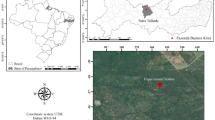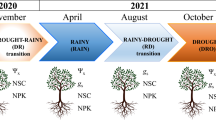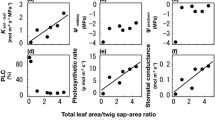Abstract
Context
Drought and frost resistances are key factors for the survival and distribution of tree species.
Aims
In this study, the vulnerability to drought-induced embolism and frost resistance of four species were analysed, whereby different sites and altitudes were compared and seasonal variation was considered.
Methods
Fagus sylvatica L., Sorbus aucuparia L., Picea abies L. Karst and Larix decidua Mill samples were harvested at high and low altitude sites in France and Austria, respectively, and sampling occurred in winter and summer. Pressure at 50% loss of conductivity (P 50), specific hydraulic conductivity (k s) and temperature lethal for 50% of cells (LT50) were determined, and soluble carbohydrate and starch content were quantified.
Results
No site-, altitude- or season-specific trend in P 50 was observed, except for S. aucuparia, which showed P 50 to decrease with altitude. Within regions, k s tended to decrease with altitudes. LT50 was between −48.4°C (winter) and −9.4°C (summer) and more negative in Tyrolean trees. Starch content was overall lower and carbohydrate content higher in winter than in summer, no site-specific or altitudinal trend was observed.
Conclusion
Studied species obviously differed in their strategies to withstand to frost and drought, so that site-related, altitudinal and seasonal patterns varied.




Similar content being viewed by others
References
Alberdi M, Romero M, Rios D, Wenzel H (1985) Altitudinal gradients of seasonal frost resistance in Nothofagus communities of southern Chile. Acta Oecol 6:21–30
Améglio T, Cochard H, Ewers FW (2001) Stem variations and cold hardiness in walnut trees. J Exp Bot 52:2135–2142
Améglio T, Decourteix M, Alves G, Valentin V, Sakr S, Julien JL, Petel G, Guilliot A, Lacointe A (2004) Temperature effects on xylem sap osmolarity in walnut trees: evidence for a vitalistic model of winter embolism repair. Tree Physiol 24:785–793
Beikircher B, Mayr S (2009) Intraspecific differences in drought tolerance and acclimation in hydraulics of Ligustrum vulgare and Viburnum lantana. Tree Physiol 29:765–775
Beikircher B, Améglio T, Cochard H, Mayr S (2010) Limitation of the cavitron technique by conifer pit aspiration. J Exp Bot 61:3385–3393
Bower AD, Aitken SN (2006) Geographic and seasonal variation in cold hardiness of whitebark pine. Can J For Res 36:1842–1850
Charrier G, Améglio T (2011) The timing of leaf fall affects cold acclimation by interactions with air temperature through water and carbohydrate contents. Environ Exp Bot 72:351–357
Charrier G, Bonhomme M, Lacointe A, Améglio T (2011) Are budburst dates, dormancy and cold acclimation in walnut trees (Juglans regia L.) under mainly genotypic or environmental control? Int J Biometeorol. doi:10.1007/s00484-011-0470-1
Chen P, Li PH (1976) Effect of photoperiod, temperature and certain growth regulators on frost hardiness of Solanum species. Bot Gaz 137:105–109
Cochard H (2006) Cavitation in trees. Comptes Rendu Physique 7:1018–1026
Cochard H, Lemoine D, Dreyer E (1999) The effects of acclimation to sunlight on the xylem vulnerability to embolism in Fagus sylvatica L. Plant Cell Environ 22:101–108
Cochard H, Damour G, Bodet C, Tharwat I, Poirier M, Améglio T (2005) Evaluation of a new centrifuge technique for rapid generation of xylem vulnerability curves. Physiol Plant 124:410–418
Cochard H, Hölltä T, Herbette S, Delzon S, Mencuccini M (2009) New insights into the mechanisms of water-stress-induced cavitation in conifers. Plant Physiol 151:949–954
Cochard H, Herbette S, Barigah T, Badel E, Ennajeh M, Vilagrosa A (2010) Does sample length influence the shape of xylem embolism vulnerability curves? A test with the cavitron spinning technique. Plant Cell Environ 33:1543–1552
Delzon S, Douthe C, Sala A, Cochard H (2010) Mechanism of water-stress induced cavitation in conifers: bordered pit structure and function support the hypothesis of seal capillary-seeding. Plant Cell Environ 33:2101–2111
Domec JC, Lachenbruch B, Meinzer FC (2006) Bordered pit structure and function determine spatial patterns of air-seeding thresholds in xylem of Douglas-fir (Pseudotsuga menziesii; Pinaceae) trees. Am J Bot 93:1588–1600
George MF, Burke MJ, Pellet HM (1974) Low temperature exotherms and woody plant distribution. Hortscience 87:39–46
Gusta LV, Tyler NJ, Chen THH (1983) Deep undercooling in woody taxa growing north of the −40 degrees C isotherm. Plant Physiol 72:122–128
Gusta LV, Wisniewski M, Nesbitt NT, Gusta ML (2004) The effect of water, sugars, and proteins on the pattern of ice nucleation and propagation in acclimated and nonacclimated canola leaves. Plant Physiol 135:1642–1653
Körner C (2007) The use of “altitude” in ecological research. Trends Ecol Evol 22:569–574
Larcher W (1972) Der Wasserhaushalt immergruener Pflanzen im Winter. Ber Dtsch Bot Ges 85:315–327
Larcher W (1980) The temperature limits for plant life. In: Physiological Plant Ecology. Springer, Berlin
Linden L (2002) Measuring cold hardiness in woody plants. Academic dissertation, University of Helsinki
Maherali H, DeLucia EH (2000) Xylem conductivity and vulnerability to cavitation of Ponderosa pine growing in contrasting climates. Tree Physiol 20:859–867
Mayr S, Wolfschwenger M, Bauer H (2002) Winter-drought induced embolism in Norway spruce (Picea abies) at the alpine timberline. Physiol Plant 115:74–80
Mayr S, Hacke U, Schmid P, Schwienbacher F, Gruber A (2006) Frost drought in conifers at the alpine timberline: xylem dysfunction and adaptations. Ecology 87:3175–3185
Medeiros JS, Pockman WT (2011) Drought increases freezing tolerance of both leaves and xylem of Larrea tridentata. Plant Cell Environ 34:43–51
Morin X, Ameglio T, Ahas R, Kurz-besson C, Lanta V, Lebourgeois F, Miglietta F, Chuine I (2007) Variation in cold hardiness and carbohydrate concentration from dormancy induction to bud burst among provenances of three European oak species. Tree Physiol 27:817–825
Pammenter NW, Vander Willigen C (1998) A mathematical and statistical analysis of the curves illustrating vulnerability of xylem to cavitation. Tree Physiol 18:589–593
Poirier M, Lacointe A, Ameglio T (2010) A semi-physiological model of cold hardening and dehardening in walnut stem. Tree Physiol 30:1555–1569
Repo T, Lappi J (1989) Estimation of standard error of impedance-estimated frost resistance. Scan J For Res 4:67–74
Sakai A (1962) Studies on the frost-hardiness of woody plants. I. The causal relation between sugar content and frost-hardiness. Cont Inst Low Temp Sci 11:1–40
Sakai A (1966) Studies of frost hardiness in woody plants. 2. Effect of temperature on hardening. Plant Physiol 41:353–359
Sakai A, Larcher W (1987) Frost survival of plants. Ecol Stud 62:1–321
Sakai A, Wardle P (1978) Freezing resistance of New Zealand trees and shrubs. N Z J Ecol 1:51–61
Sperry JS, Sullivan JEM (1992) Xylem embolism in response to freeze–thaw cycles and water stress in ringporous, diffuse-porous and conifer species. Plant Physiol 100:605–613
Sperry JS, Tyree MT (1990) Water-stress-induced xylem embolism in three species of conifers. Plant Cell Environ 13:427–436
Sperry JS, Adler FR, Campbell GS, Comstock JP (1998) Limitation of plant water use by rhizosphere and xylem conductance: results from a model. Plant Cell Environ 21:347–359
Tranquillini W (1980) Winter desiccation as the cause for alpine timberline. NZFS FRI Technical Paper 70:263–267
Tyree MT, Zimmermann MH (2002) Xylem structure and the ascent of sap. Springer, Berlin
Vogt UK (2001) Hydraulic vulnerability, vessel refilling, and seasonal courses of stem water potential of Sorbus aucuparia L. and Sambucus nigra L. J Exp Bot 52:1527–1536
Xin Z, Browse J (2000) Cold comfort farm: the acclimation of plants to freezing temperatures. Plant Cell Environ 23:893–902
Zhang MIN, Willison JHM (1987) An improved conductivity method for the measurement of frost hardiness. Can J Bot 65:710–715
Acknowledgements and funding
This study was supported by the “Austrian Academic Exchange Service”, Amadee 2009–2010, “Österreichische HochschülerInnenschaft Innsbruck” and “Fonds zur Förderung der Wissenschaftlichen Forschung”. The authors thank the Central Institute for Meterology and Geodynamics (ZAMG, Regionalstelle für Tirol und Vorarlberg) for providing climate data. We also thank the Office National des Forêts for tree samples as well as Pierre Conchon for help with cavitron measurements, Christian Bodet and Christophe Serre for help with LT50, Brigitte Girard, Brigitte Saint-Joanis and Marc Vandame for biochemical analysis as well as Birgit Dämon for assistance during measurements.
Author information
Authors and Affiliations
Corresponding author
Additional information
Handling Editor: Erwin Dreyer
Katline Charra-Vaskou and Guillaume Charrier have contributed equally to this work.
Contribution of the co-authors
Katline Charra-Vaskou and Guillaume Charrier have contributed equally and largely to this publication from experiments to correction of the manuscript. RémiWortemann, Barbara Beikircher and Hervé Cochard participated in cavitron measurements as well as manuscript preparation. Thierry Améglio was the projectleader of the French part of the Amadee cooperation. Stefan Mayr supervised theAustrian part of the project and prepared important parts of the manuscript.
Rights and permissions
About this article
Cite this article
Charra-Vaskou, K., Charrier, G., Wortemann, R. et al. Drought and frost resistance of trees: a comparison of four species at different sites and altitudes. Annals of Forest Science 69, 325–333 (2012). https://doi.org/10.1007/s13595-011-0160-5
Received:
Accepted:
Published:
Issue Date:
DOI: https://doi.org/10.1007/s13595-011-0160-5




